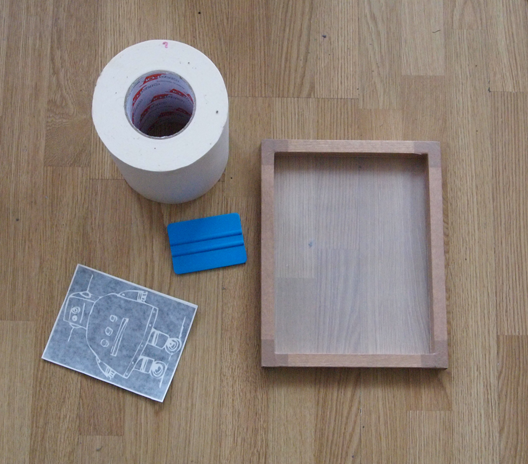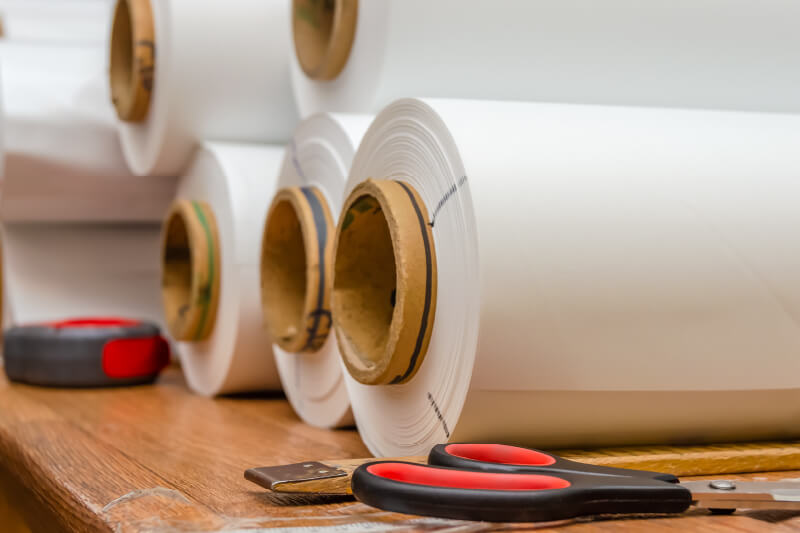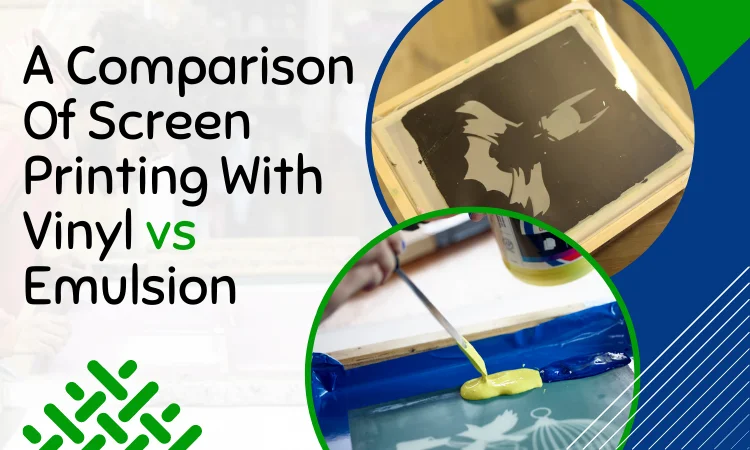Screen printing is a popular printing method used to transfer designs onto various materials, including paper, fabric, and plastic. However, there are several methods for creating a stencil for screen printing, two of which are: vinyl and emulsion.
So, screen printing with vinyl vs emulsion, which one is better?
When printing fabrics in bulk, screen printing with emulsion is the best option. The vinyl method is more suitable for small or one-time projects. Using the emulsion method, a design is burned onto the stencil and can be reused endlessly. When using the vinyl method, the stencil must be renewed after a few times, so vinyl is more expensive in the long run than emulsion.
In this article, we will dive deep and discover which screen printing method suits you well.
Screen Printing with Vinyl vs Emulsion: A General Overview
Both vinyl and emulsion are popular among businesses, but these methods have their differences. Before we dissect their unique characteristics, let’s look at a general overview of their features.
| Deciding Factors | Vinyl | Emulsion |
| Ink coverage | Better compared to emulsion | Less coverage compared to vinyl |
| Sharpness of the edges | Less sharp compared to emulsion | Can print sharper edge |
| Color vibrance | You cannot use vibrant colors in this method | It’s possible to print vibrant colors |
| Order volume | Suitable for small batches | Suitable for bulk production |
| Ease of Use | Very easy method | Can seem complicated to beginners |
| Cost Effectiveness | Can be expensive in the long run | Costs less compared to vinyl |
| Time Effectiveness | Takes less time compared to emulsion | This method consumes more time than vinyl |
| Durability | Will fade over time | Will last a lifetime |
| Sustainability | Can’t be recycled | Better compared to vinyl |
Ink Coverage:
When it comes to ink coverage, vinyl screen printing is the better option, as it allows for a more opaque print and better coverage compared to emulsion screen printing.
The vinyl material acts as a barrier between the ink and the fabric, preventing it from seeping into the fabric fibers. In emulsion screen printing, the ink is absorbed into the fabric fibers, resulting in a softer, more blended look compared to vinyl screen printing.
While emulsion screen printing can still provide good ink coverage, it can be more difficult to achieve a completely opaque print due to the ink being absorbed into the fibers of the fabric.
Winner: Vinyl

Sharpness of the Edges:
When it comes to the sharpness of the edges, emulsion screen printing may provide slightly sharper edges compared to vinyl screen printing.
In emulsion screen printing, the ink is absorbed into the fabric fibers, which creates a more blended, cohesive look. This results in a sharper edge as the ink is absorbed evenly into the fabric, creating a clean and precise print. Emulsion screen printing can also use finer mesh screens, which can result in a sharper and more detailed print.
So, choosing the right mesh screen can also make a difference.
On the other hand, in vinyl screen printing, the ink sits directly on top of the vinyl material, which can make it more difficult to achieve a completely clean edge. However, with the use of high-quality materials and printers, vinyl screen printing can still produce crisp, well-defined lines.
Winner: Emulsion
Color Vibrancy:
Emulsion screen printing is known for offering vibrant and long-lasting colors compared to vinyl screen printing. The reason for this is that the ink is absorbed into the fabric fibers, allowing it to penetrate deeply and create a more saturated and bright color. This can result in a more vibrant and eye-catching print that is less likely to fade or wash out over time. You can even do full-color screen print transfers with emulsion.
In contrast, vinyl screen printing uses ink that sits directly on top of the vinyl material, which can result in a slightly less vibrant color compared to emulsion screen printing.
Winner: Emulsion

Order Volume:
For small to medium-sized orders, vinyl screen printing can be a great option, as the setup time and process are relatively quick and efficient. For orders under 30 pieces, vinyl can be a useful method.
However, for larger quantities, emulsion screen printing is generally the better choice, as it allows for faster and more streamlined production of a high volume of prints.
The vinyl method allows for limited production because the screen can only be used for a short period of time. The emulsion screen can be reused hundreds of times, which allows for more production because the design is burned into the screen.
Because of this, printing large volumes on vinyl will not be time or cost-efficient. The same thing can be said about emulsion in small volumes.
Winner: Tie

Ease of Use:
Vinyl screen printing is often considered an easier and more straightforward process compared to emulsion screen printing.
In vinyl screen printing, the design is cut from a sheet of vinyl, and then the ink is transferred onto the garment by using a stencil and a squeegee. Then you can cure the ink to complete the process.
In contrast, emulsion screen printing requires the use of emulsion. The emulsion must be mixed and applied to the screen, and then allowed to dry and be exposed to light in order to create the stencil for the design. Then you will need to put the ink through the stencil on the garment, and then comes the curing of the ink.
So, the emulsion process requires more steps, materials, and skills, whereas the vinyl method is much simpler.
Winner: Vinyl
Cost Effectiveness:
For a smaller volume of products, vinyl printing would be the more cost-effective option. But for larger and bulk production, the emulsion method would be the best way to go.
The equipment and materials required for vinyl screen printing are relatively inexpensive and readily available. This makes it a popular choice for individuals, small businesses, and organizations that need to produce a limited number of printed garments.
But the vinyl materials aren’t as reusable as the emulsion screen. Even if you use the cheapest vinyl, it will cost you around $10 per screen. With an emulsion screen, it will cost twice as much, keeping other expenses the same.
So, vinyl t-shirts may be more expensive than an emulsion screen-printed shirt. That’s why you should consider some factors while pricing your vinyl tees to make them sell more.

Even though emulsion screen printing costs more upfront, it can be more cost-effective in the long run for large volumes. The reason for this is that emulsion screen printing is more efficient than vinyl screen printing, making it more affordable. Using emulsion screen printing, you can produce large quantities of products at a lower cost per unit as the number of units increases.
Winner: Tie
Time Effectiveness:
Vinyl screen printing is generally faster and more time-efficient than emulsion screen printing.
The process of cutting and transferring the vinyl design onto the garment is relatively quick and straightforward, without the need for emulsion coating, exposure to light, or curing time.
But emulsion screen printing is a more efficient method for producing a large number of prints. Creating the stencil is a time-consuming process. Also, it takes some time for the emulsion to dry.
Once the stencil is created, the printing itself is relatively quick and can produce a high volume of prints in a short amount of time.
However, it’s important to note that the time effectiveness of each method may also depend on the complexity of the design and the number of colors involved. For example, designs with intricate details and multiple colors may take longer to produce using either method, while simpler designs with fewer colors may be quicker and more time-efficient.
Winner: Tie
Durability:
Emulsion screen printing generally provides a longer-lasting print compared to vinyl screen printing.
In emulsion screen printing, the ink is absorbed into the fabric, creating a permanent bond between the ink and the garment fibers. This results in a print that is resistant to fading, peeling, and cracking, even after multiple washes.
On the other hand, in vinyl screen printing, the ink sits on top of the vinyl material and is then transferred onto the fabric. Because of this, the print is more susceptible to wear and tear over time. The ink may crack or peel away from the fabric, particularly with frequent washing or exposure to heat.
Winner: Emulsion
Sustainability:
Vinyl screen printing involves using a sheet of vinyl material that is made from PVC (polyvinyl chloride). This is a type of plastic that can be difficult to recycle and can release harmful chemicals when it is incinerated.
Emulsion screen printing, on the other hand, is more environment-friendly because it doesn’t involve any plastics. Although it does require some chemicals, it is generally considered to be more environmentally friendly than vinyl screen printing.
Winner: Emulsion
Screen Printing with Vinyl vs Emulsion: Which One Suits Whom and Why?
The choice between vinyl and emulsion printing will depend on the specific needs of the project.
If you’re looking to produce a simple design or a small run of items, vinyl printing may be the most cost-effective and efficient option. However, if you need to produce high-quality prints with fine details, or if you’re working with a more complex design, emulsion printing will likely be the better choice.
The vinyl printing process involves cutting out a stencil from vinyl material and then adhering it to the screen. It’s best suited for simple designs or text and is often used for promotional items like event t-shirts. With vinyl printing, you won’t need a lot of specialized equipment, and it’s easy to do. It’s also great for one-time or small runs.
In emulsion printing, a photosensitive emulsion is applied to a screen and then exposed to light. This method is best suited for more complex designs or images with fine details, as it allows for a high level of precision and control. The method of emulsion printing is often used to create high-quality prints on paper, cardboard, and fabric.
Frequently Asked Questions (FAQs):
What is the best type of screen printing?
There is no definitive “best” type of screen printing. As it depends on factors such as the design, substrate, and quantity. But the most common type of screen printing technique is the spot color technique. The ink’s stock color is printed through the stencil of the mesh to create a vibrant, solid spot of color. This is also the simplest method compared to other techniques.
What type of screen material is best?
Depending on your specific needs, there could be a couple of materials best for screens. For example, fiberglass screens provide good airflow as well as good outward visibility with minimal sunlight glare. Aluminum screens are also durable and don’t tear as easily as fiberglass. They’re rust-resistant and won’t sag. Polyester screens are resistant to tears and more durable than fiberglass.
Does screen printing crack?
Yes, screen printing can crack due to multiple reasons. For example, improper curing, inadequate ink adhesion, or excessive stretching of the substrate are a few among many causes. However, with proper techniques, high-quality ink, and suitable substrates, screen printing can be very durable and long-lasting without cracking.
Conclusion
So, between screen printing with vinyl vs emulsion, both methods have their own strengths and weaknesses. In contrast to vinyl printing, emulsion screen printing is more suitable for large quantities and more intricate designs.
It is ultimately up to you to decide whether to use one or the other based on a number of factors, including cost, durability, and the project’s specifics. To achieve the desired results for your screen printing project, you must understand the differences and advantages of each method.




